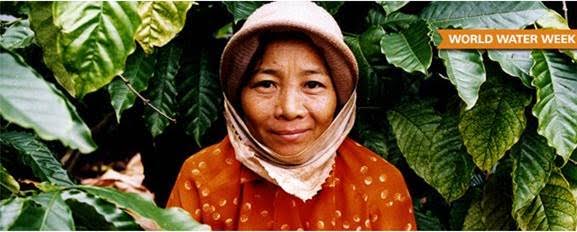
This helps them to save valuable water.
Local farmers in the central highlands of Viet Nam, the world’s second-largest coffee producer, use empty condensed milk cans to measure rainfall and put upturned plastic bottles on the ground to measure soil moisture.
They said these tools were simple to use and low cost, almost no cost, and it’s easy to scale up their use by the nation’s small coffee farms.
It is one way of facing the hard truth that climate change and overuse of water in agriculture will pose a growing threat of water scarcity to farmers, households and industry.
A study co-funded by Nestlé estimated that, on average, coffee farmers use 60 per cent more water than they need during the dry season from November to April, across three to four necessary irrigation rounds.
In Viet Nam, 2.6 million people, mostly in the Central Highlands, rely on coffee cultivation for their livelihood. Most of the coffee farms are of a small scale.
By inserting a plastic bottle upside down in the soil and observing the condensation level in the bottle, the coffee farmer is able to measure soil moisture. When the water droplets inside the bottle are few, he knows it is time for the first dry-season irrigation.
The ingenuity doesn’t end there. After this first irrigation, the farmer uses an empty condensed milk can to know how much rainwater his trees are receiving. This helps him to adjust the amount of water he will use for irrigation during the rest of the dry season. For example, if a standard milk can is one-sixth full of rainwater, he knows his trees nearby have received about 100 litres of water.
“Coffee in Viet Nam is grown on small holdings of two to three acres, and so large-scale management techniques are hard to implement. But the innovative tools made by the coffee farmers themselves show real potential,” Pham Phu Ngoc, the local head of Nestlé’s agri-service team, said.
“The bottle and the can work,” Ngoc said. “It’s more effective than using more complicated tools that could be too scientific for the farmers to master.”
Viet Nam’s coffee farmers traditionally used 700 litres to 1,000 litres of water to irrigate each tree, he said, but currently they are getting the same coffee yield using only 300 litres to 400 litres. Thus, they save more than 50 per cent in many cases.
It’s a concept that Ngoc has helped disseminate among Nestlé’s almost 20,000-strong ‘Farmer Connect’ network in the country, which supplies the company with coffee directly.
Thus, the farmers can protect themselves better from the risk of water scarcity. They can also save the financial and labour costs of the pump and fuel, and also the time spent in their fields.
Ngoc said a more important thing was that farmers found it easy to understand, and could teach their neighbours too.
Nestlé promotes more comprehensive guidelines on water conservation to its Farmer Connect network in Viet Nam, through its Nescafé Better Farming Practices, developed with the NGO Rainforest Alliance, which are part of the global Nescafé Plan.
Working with the Swiss Agency for Development and Co-operation (SDC), the company is also helping to teach more coffee farmers beyond its network in Viet Nam about good agricultural practices, including water management. –VNS
